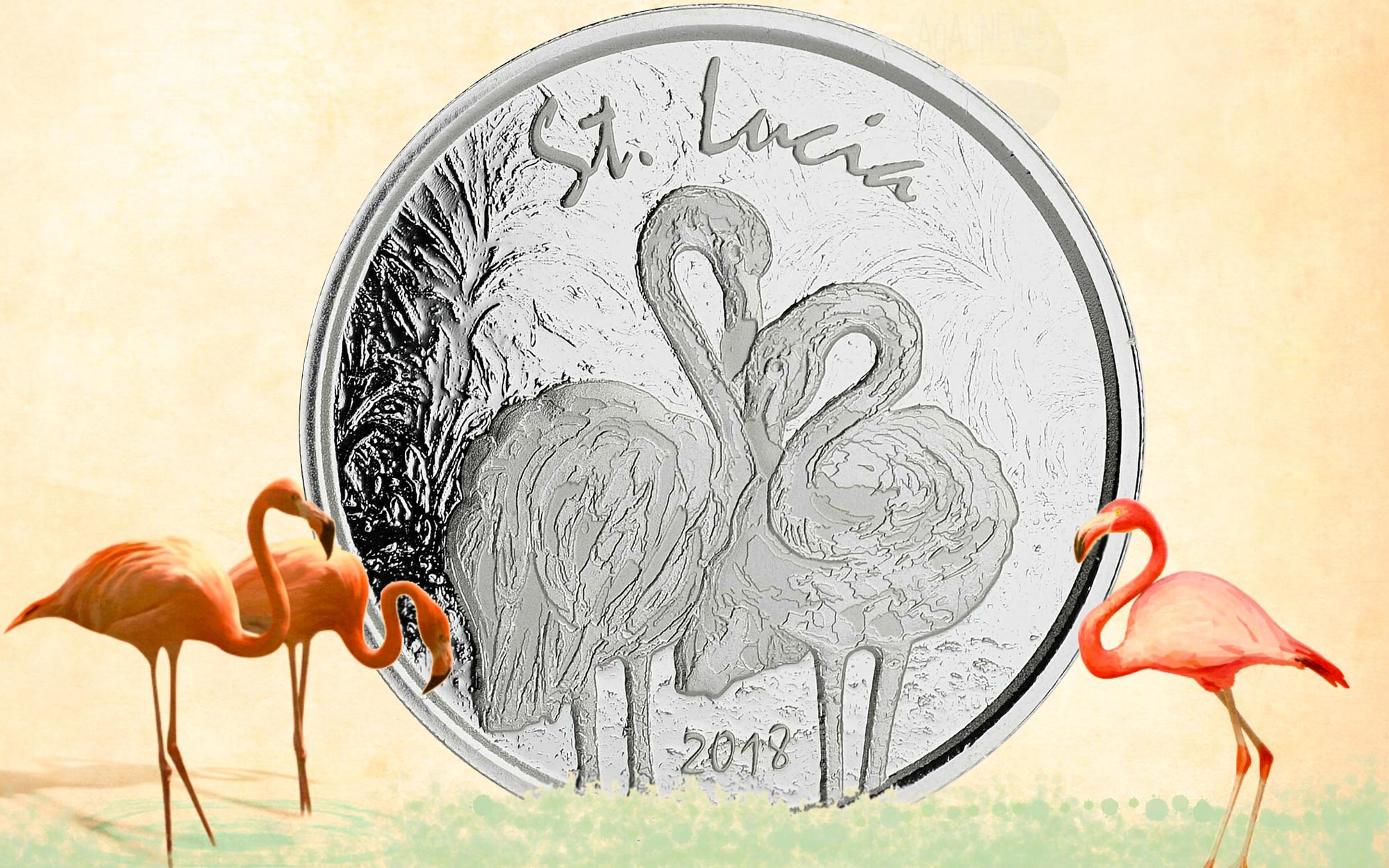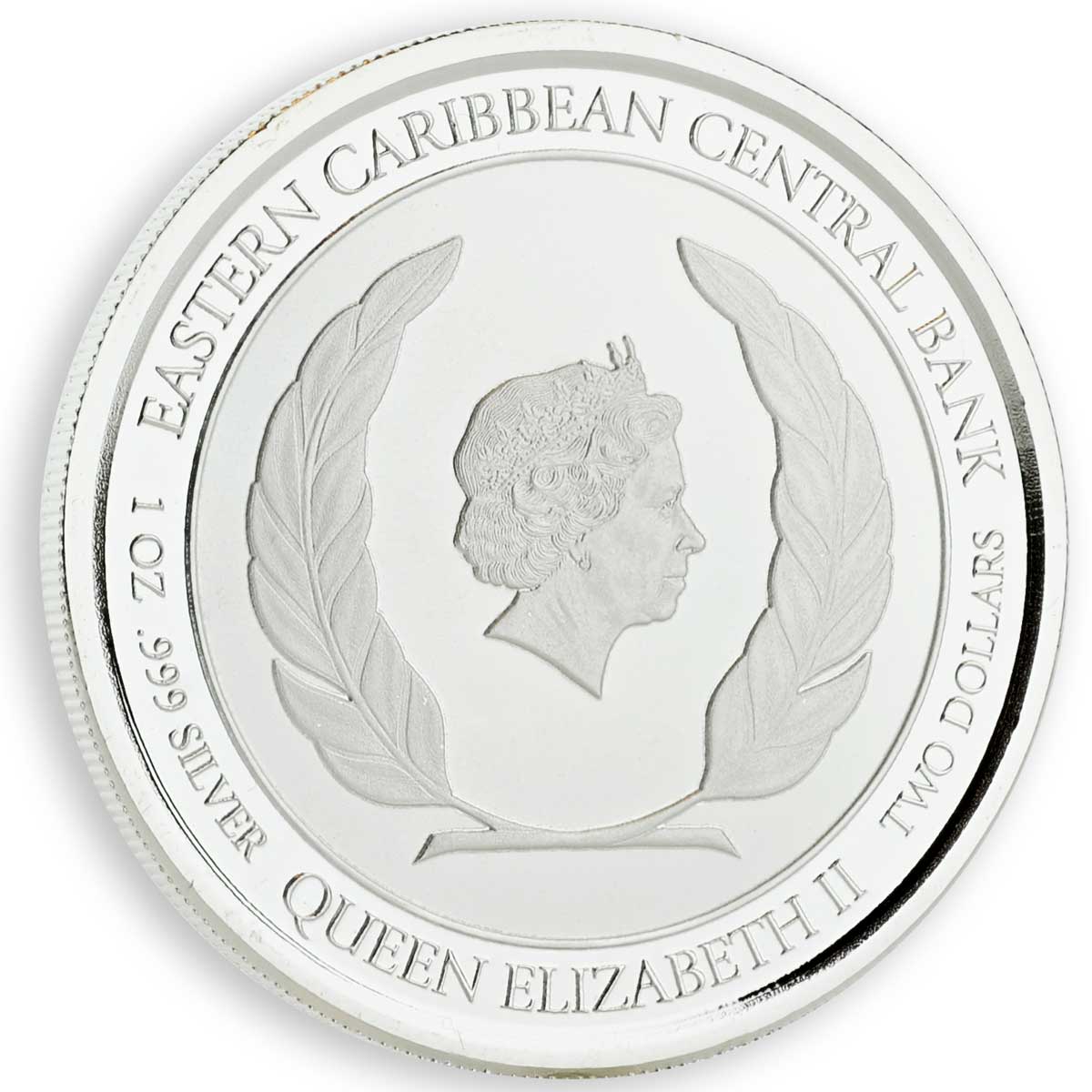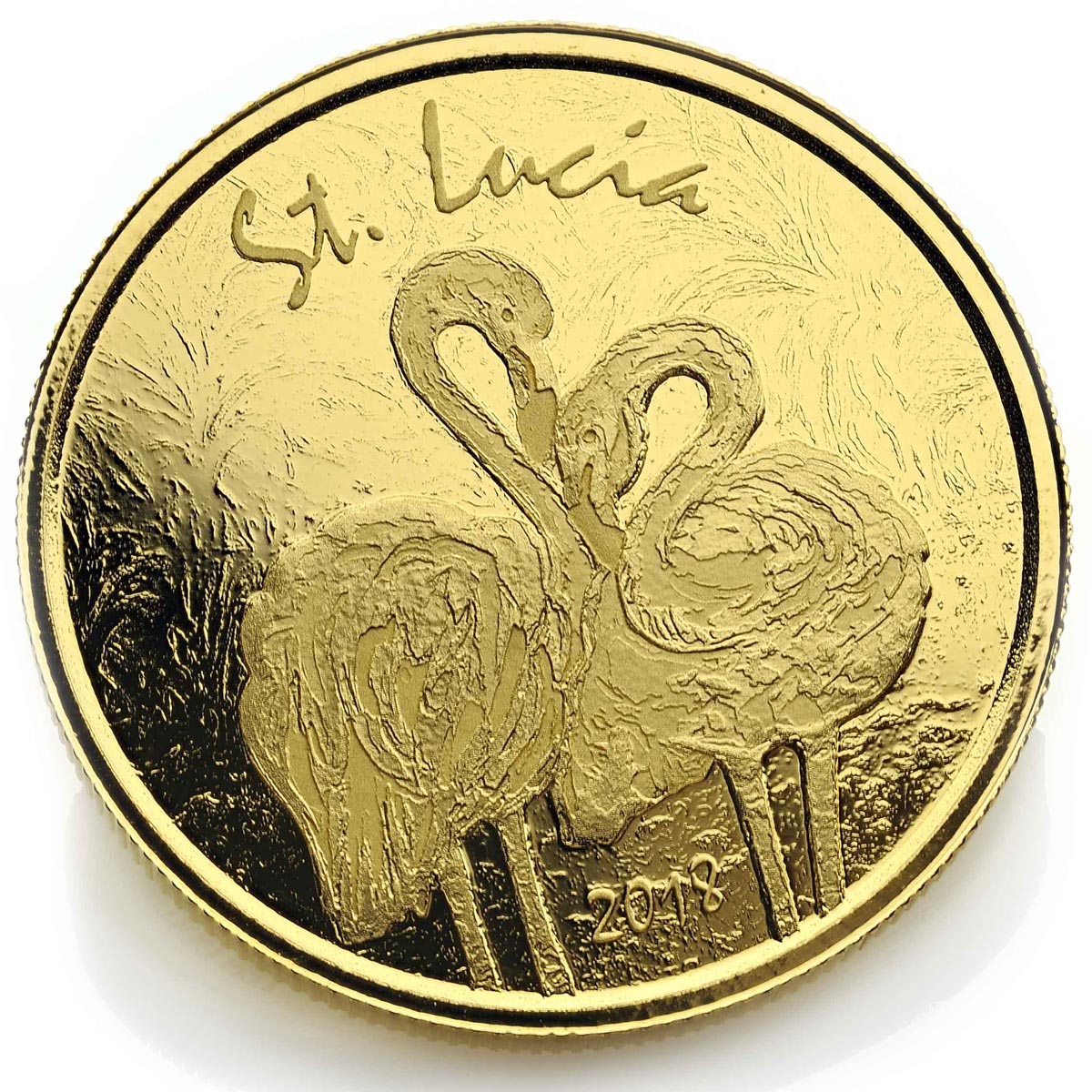Scottsdale Mints unique 2018 EC8 Caribbean bullion coin program finishes with the Saint Lucia Flamingo
The last of Scottsdale Mints eight-coin EC8 progamme is now available to order and after the relatively unadventurous seaplane design used for the Saint Vincent & the Grenadines, this is a real return to top form. Issued for Saint Lucia, this is a beautiful impressionistic depiction of a pair of Flamingoes. This series has dabbled in quite a few styles, with the Grenada and Anguilla ones standing out, at least in our view. It’s good to see the 2018 EC8 go out in style with this series best Flamingo design, and nice to see a wildlife bullion coin that isn’t just another staid depiction of the animal. Excellent.
The bullion coin comes as a 1oz 0.999 silver (25,000 mintage) and a 1oz 0.9999 gold (2,500), with the boxed and certified proof coloured coins topping out at a 2,500 mintage in silver, and 500 in gold. The bullion variants ship in capsules on customized Scottsdale Mint branded skin boards of five, although dealers will sell them individually. The Gold “Flamingo” BU coins will ship in Scottsdale Mint’s Certi-Lock® packaging. You can see the whole series to date in our Bullion Profile of the range. We’ve yet to have confirmed if the series will return in 2019 and/or if the designs will be reused or changed. We’ll let you know when we do.
MINTS DESCRIPTION
Scottsdale Mint, in partnership with the Eastern Caribbean Central Bank (“ECCB”), is pleased to announce an historic, first-of-its-kind gold and silver bullion and commemorative coin program – the “EC8”. The EC8 program will consist of four coins minted in 2018 on behalf of each of the eight Caribbean island members that comprise the ECCB – Anguilla, Antigua and Barbuda, Commonwealth of Dominica, Grenada, Montserrat, Saint Kitts and Nevis, Saint Lucia, and Saint Vincent and the Grenadines. The ECCB is the official issuer of the Eastern Caribbean Dollar – the Currency of the EC8 2018 Coin Program. These coins are legal tender in the territories of all eight members that comprise the Eastern Caribbean Central Bank.
The 2018 EC8 St. Lucia coin depicts a pair of pink flamingos. Blessed by nature, St. Lucia has geographic and cultural riches enough to embarrass far bigger nations. This Caribbean country boasts a fantastically unique bird-watching experience, whether on the beach or in the islands mountain regions.
LIMITED PROOF VARIANTS
ST. LUCIA
Saint Lucia is a sovereign island country in the West Indies in the eastern Caribbean Sea on the boundary with the Atlantic Ocean. Part of the Lesser Antilles, it is located north/northeast of the island of Saint Vincent, northwest of Barbados and south of Martinique. It covers a land area of 617 km² (238 square miles) and reported a population of 165,595 in the 2010 census. Its capital is Castries.
The French were the island’s first European settlers. They signed a treaty with the native Island Caribs in 1660. England took control of the island from 1663 to 1667. In ensuing years, it was at war with France fourteen times, and rule of the island changed frequently (it was ruled seven times each by the French and British). In 1814, the British took definitive control of the island. Because it switched so often between British and French control, Saint Lucia was also known as the “Helen of the West Indies”.
Representative government came about in 1840 (universal suffrage was established in 1953). From 1958 to 1962, the island was a member of the West Indies Federation. On 22 February 1979, Saint Lucia became an independent state and a member of the Commonwealth of Nations. Saint Lucia is a mixed jurisdiction, meaning that it has a legal system based in part on both the civil law and English common law. The Civil Code of St. Lucia of 1867 was based on the Quebec Civil Code of 1866, as supplemented by English common law-style legislation. It is also a member of Organisation internationale de la Francophonie.
Christopher Columbus may have sighted the island during his fourth voyage in 1502, since he made landfall on Martinique, yet he does not mention the island in his log. Juan de la Cosa noted the island on his map of 1500, calling it El Falcon, and another island to the south Las Agujas. A Spanish Cedula from 1511 mentions the island within the Spanish domain, and a globe in the Vatican made in 1520, shows the island as Sancta Lucia. A 1529 Spanish map shows S. Luzia. One of the Windward Islands, Saint Lucia was named after Saint Lucy of Syracuse. It is the only country in the world named after a historical woman (Ireland is named after the Celtic goddess of fertility Eire). Legend states French sailors were shipwrecked here on 13 December, the feast day of St. Lucy, thus naming the island in honor of Sainte Lucie
(Source: Wikipedia)
| SPECIFICATION | ||||
| DENOMINATION | $2 East Caribbean | $2 East Caribbean | $10 East Caribbean | $10 East Caribbean |
| COMPOSITION | 0.999 silver | 0.999 silver | 0.9999 gold | 0.9999 gold |
| WEIGHT | 31.1 grams | 31.1 grams | 31.1 grams | 31.1 grams |
| DIAMETER | 38.6 mm | 38.6 mm | 38.6 mm | 38.6 mm |
| FINISH | Brilliant uncirculated | Proof | Brilliant uncirculated | Proof |
| MODIFICATIONS | None | Colour | None | Colour |
| MINTAGE | 25,000 | 2,500 | 2,500 | 500 |
| BOX / COA | No / No | Yes / Yes | No / No | Yes / Yes |









Leave A Comment